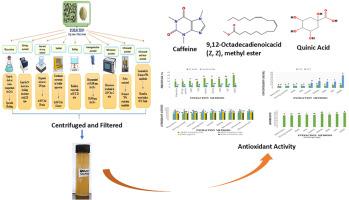Assessing the influence of extraction techniques on the phytochemical composition of green coffee (Coffea arabica) using principal component analysis (PCA) and hierarchical cluster analysis (HCA)
IF 3.4
4区 化学
Q2 CHEMISTRY, MULTIDISCIPLINARY
引用次数: 0
Abstract
This study aimed to compare different extraction methods to determine their effects on the antioxidant properties and phytochemical composition of green coffee. A total of nine extraction techniques were evaluated based on their impact on extraction efficiency, total phenolic and flavonoid content, and antioxidant activity. Statistical analyses, including Principal Component Analysis (PCA) and Hierarchical Cluster Analysis (HCA), were applied for data interpretation. The findings indicated that the Ultrasonic-Assisted Microwave Extraction (UMAE) method achieved the highest extraction efficiency, along with the greatest total phenolic and flavonoid content and antioxidant activity. Notably, most analytical parameters showed a strong correlation with the first principal component (PC1), which accounted for approximately 80.40 % of the total variance. Hierarchical Cluster Analysis, represented through a heatmap, further confirmed that all parameters associated with the UMAE method consistently exhibited the highest values. Qualitative analysis and Fourier Transform Infrared (FTIR) spectroscopy validated the presence of key phytochemical compounds, including phenols, alkaloids, flavonoids, and aromatic compounds. Furthermore, Gas Chromatography-Mass Spectrometry (GC-MS) analysis identified caffeine as the dominant compound in the extracted samples.

利用主成分分析(PCA)和层次聚类分析(HCA)评估提取工艺对绿咖啡(Coffea arabica)植物化学成分的影响
本研究旨在比较不同提取方法对绿咖啡抗氧化性能和植物化学成分的影响。根据提取效率、总酚和总黄酮含量以及抗氧化活性对9种提取工艺进行了评价。采用主成分分析(PCA)和层次聚类分析(HCA)等统计分析方法进行数据解释。结果表明,超声辅助微波提取(UMAE)法提取效率最高,总酚和总黄酮含量最高,抗氧化活性最高。值得注意的是,大多数分析参数显示与第一主成分(PC1)有很强的相关性,PC1约占总方差的80.40%。通过热图表示的分层聚类分析进一步证实,与UMAE方法相关的所有参数都一致显示出最高值。定性分析和傅里叶变换红外光谱(FTIR)验证了主要植物化学成分的存在,包括酚类、生物碱、类黄酮和芳香族化合物。此外,气相色谱-质谱(GC-MS)分析表明,咖啡因是提取样品中的主要化合物。
本文章由计算机程序翻译,如有差异,请以英文原文为准。
求助全文
约1分钟内获得全文
求助全文
来源期刊
CiteScore
3.50
自引率
7.70%
发文量
492
审稿时长
3-8 weeks
期刊介绍:
The Journal of the Indian Chemical Society publishes original, fundamental, theorical, experimental research work of highest quality in all areas of chemistry, biochemistry, medicinal chemistry, electrochemistry, agrochemistry, chemical engineering and technology, food chemistry, environmental chemistry, etc.

 求助内容:
求助内容: 应助结果提醒方式:
应助结果提醒方式:


